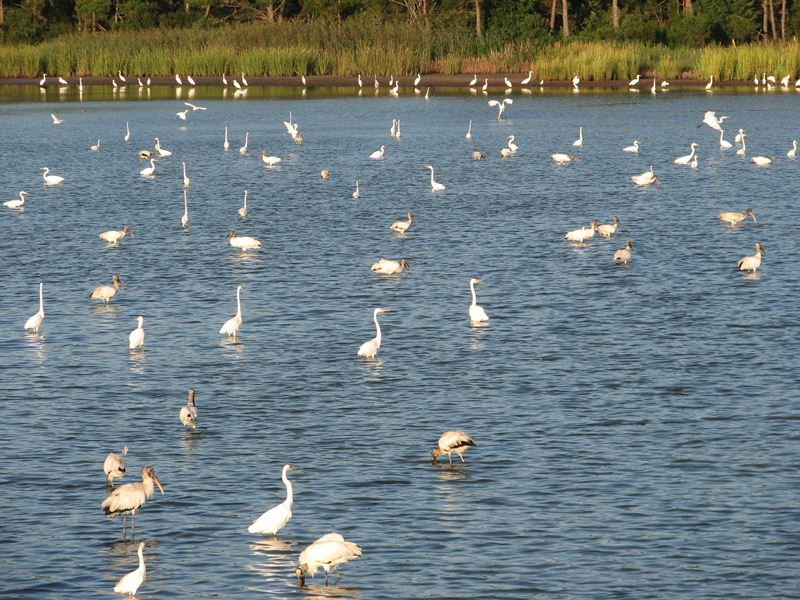Trip to Huntington Beach State Park, September 10, 2011
Steve Shultz
Several members of the Carolina Bird Club converged on Huntington Beach State Park in South Carolina on Saturday September 10 for a field trip. While the beautiful weather was not overly conducive to seeing numbers of passerine migrants, shorebirds put on a decent show, the waders were nothing less than spectacular, a shark made an appearance, and 92 species were tallied for the day.
Highlights from the trip include the amazing sight of a staggering number of waders in Mullet Pond early in the morning. By mid-morning most of the birds departed and a visitor might wonder what all the fuss was about, but a few hours earlier hundreds and hundreds of herons, egrets, and other waders virtually covered this small impoundment in white. Hundreds of herons, egrets, and WOOD STORKS mixed with a young REDDISH EGRET, 2 pink ROSEATE SPOONBILLS, and several species of tern to feed on a significant concentration of small fish. Successful catches were often followed by gangs of hungry waders chasing the lucky fisherman. Who knew Wood Storks were so bullyish? We even watched one stare down an alligator for a treasured roosting spot... and win!
Shorebirds of various sizes and types padded around the muddy margins of Mullet, including an uncommon "inland" sighting of RED KNOT and the more expected STILT SANDPIPER and PECTORAL SANDPIPERS among the more common and expected species. Plenty of BLACK TERNS patrolled overhead, and recently arrived BLUE WINGED TEAL formed the vanguard of the dabblers that will take over the pond come winter.
The slog to the jetty was generally unremarkable except for a 3–4 foot shark seen and watched for 5–10 minutes as it pursued a school of mullet that could be seen each time a wave crested.
While the jetty crew surveyed the tern roost at the inlet, some of the others beat the bushes for migrants, coming away with some nice finds as noted earlier by Jess Gorzo. The LEAST FLYCATCHER was a write-in on the park's birdlist, always a nice feeling. For PAINTED BUNTING fans plenty of green ones at the Education Center feeders. Jess also spotted a "out of range" SEASIDE SPARROW at Mullet Pond. OK. Their normal range is 24 feet away on the other side of the causeway, but still...

Species Observed
|
Blue-winged Teal Pied-billed Grebe Wood Stork Double-crested Cormorant Brown Pelican Great Blue Heron Great Egret Snowy Egret Little Blue Heron Tricolored Heron Reddish Egret Green Heron Black-crowned Night-Heron Yellow-crowned Night-Heron White Ibis Roseate Spoonbill Black Vulture Turkey Vulture Osprey Bald Eagle Northern Harrier Red-shouldered Hawk Clapper Rail Common Gallinule Black-bellied Plover Semipalmated Plover Killdeer American Oystercatcher Spotted Sandpiper Greater Yellowlegs Willet |
Lesser Yellowlegs Ruddy Turnstone Red Knot Sanderling Semipalmated Sandpiper Western Sandpiper Least Sandpiper Pectoral Sandpiper Stilt Sandpiper Short-billed Dowitcher Laughing Gull Ring-billed Gull Herring Gull Least Tern Caspian Tern Black Tern Common Tern Forster's Tern Royal Tern Sandwich Tern Black Skimmer Mourning Dove Yellow-billed Cuckoo Chimney Swift Ruby-throated Hummingbird Red-headed Woodpecker Red-bellied Woodpecker Downy Woodpecker Pileated Woodpecker Least Flycatcher Eastern Kingbird |
Red-eyed Vireo Blue Jay American Crow Purple Martin Tree Swallow Barn Swallow Carolina Chickadee Tufted Titmouse Brown-headed Nuthatch Carolina Wren Blue-gray Gnatcatcher Gray Catbird Northern Mockingbird Brown Thrasher Ovenbird Tennessee Warbler Common Yellowthroat American Redstart Yellow Warbler Chestnut-sided Warbler Pine Warbler Prairie Warbler Seaside Sparrow Summer Tanager Northern Cardinal Painted Bunting Bobolink Red-winged Blackbird Common Grackle Boat-tailed Grackle |

